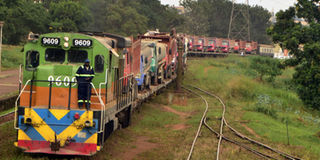Prime
Railway museum to bring back memories of wheels of steel

The rail wagons loaded with trucks arrives at Kampala Railway Station from Mombasa on January 10, 2018. To link Kampala directly to the Indian Ocean coast, a bridge was built across River Nile in 1926 and the railway finally reached the city in 1931. PHOTO/MICHAEL KAKUMIRIZI
Plans are in high gear to open a national railway museum in Uganda in order to preserve the rich historical heritage of the vast railway network and its impact in terms of colonialism and development, social-economic and racial relations in the country, and neighbouring Kenya and Tanzania.
The proposed National Railway Museum will be located at Jinja Railway Station in Jinja City.
Financed by the European Union (EU) and SOGEA (the company rehabilitating the Tororo – Pakwach railway line), and co-managed by the Uganda Railways Corporation (URC) and the Cross-Cultural Foundation of Uganda (CCFU), the museum will provide visitors with a unique experience in one of the oldest railway stations in the country.
A visitor will be able to trace the history of our railways through photographs, diagrammes and unique artefacts; watch a film where those most concerned recollect the days of the railways; visit a locomotive and railway carriage; appreciate the explanations of a trained guide; and enjoy all amenities, including a shop and cafeteria.
“It will be a new museum, using interactive methods. It is meant, especially to attract children who might have never had a chance to see a train, let alone be a rail passenger,” the CCFU programme advisor, John De Coninck, told Sunday Monitor.
“Different artefacts have been collected from along the lines and stations. These include lamps, telephony instruments, railway tools, a ticketing cupboard, among others,” De Coninck added.
“The museum will occupy about two or three thirds of the Jinja Railway Station, plus the forecourt where an exhibition coach and locomotive will be accessible to visitors,” De Coninck said.
The museum that has blessings from the Department of Museums and Monuments is expected to be opened to the public by the end of this year.
CCFU held an exhibition under the theme “Our railways – our history” at the Uganda National Museum in Kampala from December 9 to 17, 2020.
As to the importance of having this museum, De Coninck, said: “Railways have shaped the history of the country, right from the beginning of the colonial period until the 1970s.”
As for the roles this museum will play in the tourism industry in Uganda, De Coninck, said: “We need to diversify the tourism products on offer in the country. This is one way to do it.”
CCFU is appealing to the public to donate or lend artefacts or old photos to the museum.
The beginning
When Uganda became a British Protectorate on June 18, 1894, the colonial power (Britain) immediately embarked on an integrated scheme of exploiting the new East African country for its raw materials that fed the industries of the British Empire. Uganda soon became a source for cotton (white gold), and later coffee and copper ingots.
It was a missionary named Kristen Borup who first vigorously encouraged the planting of cotton in 1903. This was to become Uganda’s main export crop until the 1930s (Ugandan peasants were soon forced to grow the crop to pay taxes).
The challenge then was how to transport it to the coast. By 1901, the “Uganda Railway” had reached Kisumu, all the way from Mombasa, but there was no rail within Uganda.
From Kisumu, all merchandise was carried either on foot, by cart, or by steamer ship. The first large steamer to be launched on Lake Victoria was built in Scotland and brought, piece by piece, to the lake shore where it was re-assembled and launched in 1903. From there, the ships would go to Port Bell in Luzira, Uganda.
According to CCFU, with time, a vast network of steamship routes was created with ports along the shore of Lake Victoria, up and down the Nile from Namasagali to Masindi port, and on Lake Albert from Butiaba to Pakwach and Nimule, at the border with Sudan.
Eventually, roads and rails led to the disappearance of most ship transport in Uganda, precipitated by the floods of 1963-1964, which submerged most of the ports following unusual amount of rain that Uganda received between 1961 and 1963. The ports were eventually abandoned. The age of steam ships was coming to an end.
Much of the cotton then grown in Uganda was in Buganda and, after ginning, traders would store it in “go-downs” in Kampala.
Indian businessmen – many of whom had worked on the construction of the Uganda Railway – became middlemen in the cotton trade and by 1925, they owned about three quarters of the cotton ginneries in the country, a subject of growing resentment over the years by the African population.
The first line: Kampala – Port Bell (1912-1014)
The six-mile line was originally known as the Luzira Railway and was built as a Ewing monorail.
The line was opened in 1909, with the rolling stock pulled by bullocks. Many of the oxen, however, soon died and the tractors that replaced them were involved in accidents. The line was very inefficient: it could take two days to cover the distance and head porterage or carts between Kampala and Port Bell was deemed more effective.
In 1912, the construction of the first “proper” railway line in Uganda started. It took two years to build (it was much delayed by one of the British builders corruptly selling off in town the timber meant for construction!). It relieved congestion in the cotton stores and reduced the transport times to the Indian Ocean coast.
The “cotton lines” – Bombo and the Busoga line
At the turn of the century, there was also an attempt at a “small railway” (hence the name “Kalerwe” in Kampala) to link Kampala with Bombo, where cotton production was developing.
Commercial operations on the Kampala - Kawempe section started in 1923, with 3,700 tonnes of cotton transported by the end of the season. The two tractors, however, did not perform to expectation and were replaced with bigger and more powerful ones. Later, the line was extended to Bombo, but rail traffic nevertheless ended in 1926.
A much larger effort was made in eastern Uganda: a 61-mile long line was built to connect Jinja to Busoga, partly to encourage cotton production and partly to link with steamer services. This became known as the Busoga line and connected to Namasagali in 1913, where the steamers also docked.
Namasagali (where the school now stands) became an important hub of economic activity. It is on this line that the oldest station is still standing in the country – built in 1914 – can be found.
In Jinja, a pier was built to receive steamers, as well as a railway station (now demolished). This pier is possibly among the first large industrial investments made in the country. It was later designed to go up and down with large pulleys to allow wagons on and off ferries. Jinja had become the most important port in Uganda.
This line had a large impact on local economies: by 1915, Busoga, Bukedi, Teso all saw big increases in the number of acres under cotton cultivation. Even Lango, which was accessed via Lake Kyoga steamers, followed suit. At every station, cotton stores and drying racks for cotton bales were built.
Linking Jinja to Mombasa
By the 1920s, Uganda’s export economy still relied on a complicated trans-shipment system. Cotton grown in Teso, for instance, would be transported to Lake Kyoga, put on a steamer to Namasagali, then by train to Jinja, then onto another steamer from Jinja to Kisumu, and finally to Mombasa by rail.
The colonial authorities, therefore, invested in a more direct connection: a line linking Jinja and Namasagali to Mombasa directly.
By 1924, a decision had been taken to extend the railway in Kenya across the border into Uganda at Tororo, leading to an economic boom in the town: in 1926 it was a minor trading centre, but, within one year, 54 commercial land leases had been taken out. The line was then extended across the Mpologoma swamp to Kamuli and Mbulamuti, near Namasagali in 1928.
Bridging the Nile and reaching Kampala
The next step in the giant Uganda railway jigsaw was linking Kampala directly to the Indian Ocean coast. A bridge was built across the river in 1926 and the railway finally reached the city in 1931. The bridge (designed to carry trains, as well as vehicles on a separate deck below) was quite an engineering feat at the time! All the steel parts were fabricated in Scotland and reassembled on the site.
The arrival of the train at Kampala was an all-important event, long reflected in the design of the city.
There was now a direct connection between Kampala and Mombasa and it only took two days!
In the 1950s, there were daily trains to and from the coast, transporting goods. The passenger trains had restaurant cars and sleeping accommodation and took passengers to Mombasa twice a week.
These developments also necessitated the construction of a new station in Jinja in the late 1920s, but the Jinja pier closed as its economic importance dwindled (although it reopened in 1961 for a steamer service transporting goods to and from what was then Tanganyika).
Tororo – Soroti, 1929
Meanwhile, in the continued drive to expand into cotton-producing areas, the line was extended north-westwards from Tororo to Mbale (in 1926 – 35 miles) and to Soroti (in 1929 – 65 miles).
The western line to Kasese
The 208-mile from Kampala to Kasese took five years to build. Although there had been grand schemes to build such a line since the 1910s, the decision reflected the opening of the copper mines at Kilembe in the Rwenzori mountains, itself made possible by the laying of this new railway connection. The inaugural train reached Kasese in August 1956.
This development was also linked to the development of the copper smelter in Jinja. Copper ore could henceforth be transported by train from Kasese directly to Jinja, where a copper smelter was built.
Smelting requires larger amounts of electricity and the Jinja Copper Smelter was for long the largest consumer of power produced from 1954 at the new Owen Falls Dam – now Nalubaale Dam. From Kilembe to Mombasa, it was all part of a vast, integrated scheme.
By 1956, there were 1,266 kilometres of rail in Uganda and much of the national economy (which was export-oriented) depended on this infrastructure.
The last effort: Soroti - Gulu
The desire to bring more cotton growing areas to proximity of the rail led to the last major project in the colonial period.
By June 1962, the line had reached Lira, and Gulu by early 1963. A plan had also been developed to take the line all the way to the River Nile, at Pakwach.
On the way to Pakwach
As Uganda became independent, the immediate task was to complete the Northern Line. The Northern Uganda Extension which began at Soroti, in October, 1960, reached Pakwach East, on the shores of the Nile River, on January 31, 1964, when the last rail was laid, thus completing 213 miles of the new track.




